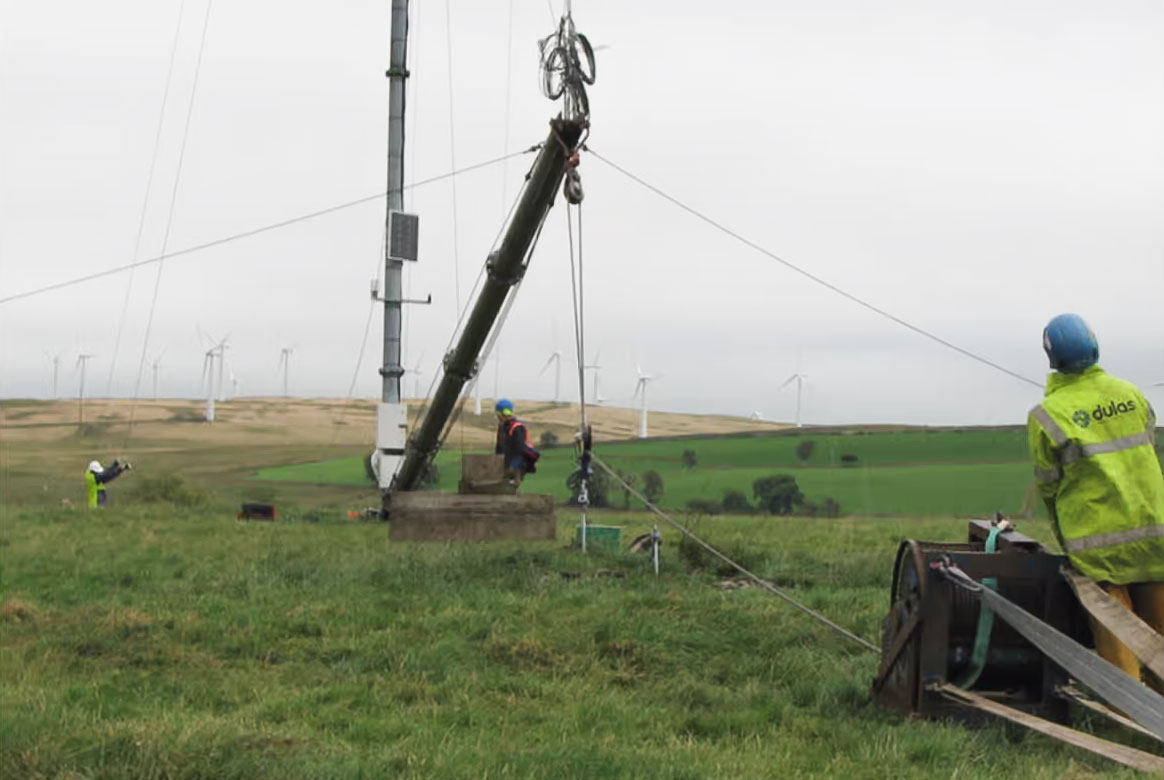From planning to decom: Wind monitoring at a site in Wales
Wind monitoring is one of Dulas’ core activities. We have many decades of experience and offer a complete service, from initial planning, through installation and operation right up to decommissioning.
Project overview
A major energy supplier asked us to install a met mast at a remote upland location in Wales. The wind data was to be collected using instruments mounted on a 90-metre met mast, comparable in height to the anticipated hub height of the wind turbines. As well as wind speeds and directions at different heights, the data would also show the impact of the site’s topography, and as a result, identify the optimal siting of each turbine. Additionally, the data would be used for overall wind farm energy generation calculations (to give an expected capacity factor) and can also be used during noise monitoring.

Images shown are of another Dulas project in the UK
Planning
The process of installing a met mast starts long before the actual build. Every mast is subject to local authority approval, and before this is granted, various criteria must be surveyed and assessed. These can include impact on the local ecology and local archaeology, which has to be noted and protected from potential damage. Any constraints arising from the legal status of the land – common land, forestry, rights of way – must also be addressed.
In this particular instance, the intended location of the site is an area of upland grazing. Our site surveyors identified a suitable location that would deliver the required wind data.
Dulas’ ability to handle every aspect of a wind monitoring campaign in-house delivers a significant advantage over other providers. Should a site surveyor be unfamiliar with the installation process, incorrect siting can result in many logistical issues. The only options are to then either proceed with a sub optimal location or resubmit to the local planning authority, both incurring additional expense and delay.

Raising the mast: the gin pole comes down from vertical to horizontal, so the mast goes up.
(Photo from another Dulas project in the UK)
Installation
The tilt-up mast sections were transported as close to site as possible via road and then by tractor and trailer across the difficult terrain. The tubular tilt-up mast sections are then bolted together on the ground and once assembled a 20m gin pole is used to lever the mast into a vertical position via turfer winch.
Our tubular tilt-up masts are held in place by eight galvanised steel guy wires, anchored around the mast. As the mast is raised to the vertical position, adjustments are made as necessary to equalise the tension in all eight guys. As the gin pole moves from vertical to being flat on the ground, the met mast is raised to the vertical.
Instruments are then mounted onto the mast at various heights and we use a combination of solar PV and battery storage to power the aviation light atop the mast.

The PV array and the datalogger. The datalogger includes a modem so that the collected wind data can be examined remotely.

In operation
Met masts generate a vast amount of wind data and all of the data is downloaded and examined through a web portal.
Dulas undertake two maintenance visits per annum, checking the instruments and the integrity of the mast and guy lines. When the time comes, we will also handle the decommissioning of the site. This will involve not only removing the mast and associated equipment but also returning the site to its original state.
Benefits delivered
A one-stop solution
The initial site survey, planning application, design and build of the mast, instruments and power supply are all handled in-house.
Single point of contact
As we handled the whole process, our client had just one point of contact throughout the entire project.
Reduced risk
By handling everything ourselves, problems are avoided that can easily arise when multiple agencies lack a holistic overview of a project.
Accurate, bankable data
The met mast not only provides the data needed for the optimal siting of turbines but is also ‘bankable’ (acceptable to investors).
Share: